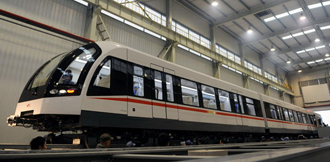China Firm Produces Low-Cost Maglev Train
By wchung | 23 Dec, 2025
A firm in Hunan province unveiled a magnetically levitated (maglev) train that is both far less expensive and more environmental-friendly than conventional trains, according to China Economic Net.
The train has a top speed of 100 km per hour (63 mph) and carry 600 passengers in its three cars, said Xu Zongxiang, general manager of Zhuzhou Electric Locomotive which is a subsidiary of state-owned China South Locomotive and Rolling Stock Corporation (CSR).
Because the Zhuzhou train levitates on guideways, it produces no rolling friction, making it much quieter than conventional trains.
“It’s ideal for mass transportation, as it is quiet and environmental-friendly. Its manufacturing cost is about 75% of a conventional light-rail train,” said Xu. “It’s an ideal public transport option for Chinese cities and major tourist destinations.”
The train has a minimum turning radius of 50 meters (163 feet) and is designed for residential communities or hilly terrain.
“It can be used for public transport in populous areas and at scenic spots with fragile environments,” said Railway transport specialist Liu Youmei. He said the new train is green, economical and safe.
China is one of very few countries that have applied maglev technology, along with Japan, Germany, S. Korea and Canada.
A German maglev train system began operating in Shanghai on December 31, 2002 as the world’s first commercial maglev system. Its 30-km route links the city’s downtown business district with Pudong airport.
The Daitai maglev line is currently being built in Beijing. One terminus is the IT center in the Haidian district. The other is the Mentougou district on the western edge of the city. It will pass through the Shijingshan entertainment and residential district when it begins operation in 2013.
Maglev trains can attain high speeds not possible with conventional rail systems. A speed record of 581 km/h (361 mph) was achieved in 2003 by Japan’s CJR’s MLX01 superconducting maglev. That speed is 6 km/h (3.7 mph) faster than the conventional wheel-rail speed record set by France’s conventional-rail TGV. Maglev trains are also known for having lower maintenance costs than conventional rail trains.

The 600-passenger Zhuzhou maglev train can hit a top speed of 100 kpm (63 mph) and costs only 75% as much as a comparable conventional train.
Asian American Success Stories
- The 130 Most Inspiring Asian Americans of All Time
- 12 Most Brilliant Asian Americans
- Greatest Asian American War Heroes
- Asian American Digital Pioneers
- New Asian American Imagemakers
- Asian American Innovators
- The 20 Most Inspiring Asian Sports Stars
- 5 Most Daring Asian Americans
- Surprising Superstars
- TV’s Hottest Asians
- 100 Greatest Asian American Entrepreneurs
- Asian American Wonder Women
- Greatest Asian American Rags-to-Riches Stories
- Notable Asian American Professionals

